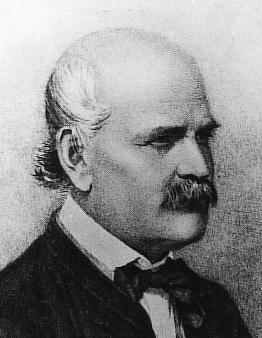| Ignaz Semmelweis  AKA Ignác Fülöp Semmelweis AKA Ignác Fülöp Semmelweis
Born: 1-Jul-1818
Birthplace: Budapest, Hungary
Died: 13-Aug-1865
Location of death: Vienna, Austria
Cause of death: Accident - Misc
Remains: Cremated, Semmelweis Museum of Medical History, Budapest, Hungary
Gender: Male
Religion: Roman Catholic
Race or Ethnicity: White
Sexual orientation: Straight
Occupation: Doctor Nationality: Hungary
Executive summary: Pioneer of antiseptics Hungarian physician, was born at Buda on the 1st of July 1818, and was educated at the universities of Pest and Vienna. At first he intended to study law, but soon abandoned it for medicine; and such was his promise that, even as an undergraduate, he attracted the attention of men like Joseph Skoda and Carl Rokitansky. He graduated M.D. at Vienna in 1844, and was then appointed assistant professor in the maternity department, under Johann Klein.
In Klein's time the deaths in this department from what was then known as puerperal fever became portentous, the ratio being rarely under 5% and sometimes exceeding 7.45%. Between October 1841 and May 1843, of 5139 parturient women 829 died; giving the terrible death-rate of 16%, not counting those of patients transferred to other wards. It was observed that this rate of mortality prevailed in the students' clinic; in the midwives' clinic it ruled much lower. Semmelweis found no satisfactory explanations of this mortality in such causes as overcrowding, fear, mysterious atmospheric influences or even contaminated wards; yet that the cause lay in some local conditions he felt certain. The patients would die in rows, others escaping; and women delivered before arrival, or prematurely, would escape.
At last, he tells us, the death of a colleague from a dissection wound "unveiled to my mind an identity" with the fatal puerperal cases; and the beginning of a scientific pathology of septicaemia was made. The students often came to the lying-in wards from the dissecting room, their hands cleansed with soap and water only. In May 1847 Semmelweis prescribed ablutions with chlorinated lime water: in that month the mortality stood at 12.24%; before the end of the year it had fallen to 3.04%, and in the second year to 1.27%; thus even surpassing the results in the midwives' clinic.
Skoda and other eminent physicians were convinced by these results. Klein, however, apparently blinded by jealousy and vanity, supported by other reactionary teachers, and aided by the disasters which then befell the Hungarian nation, drove Semmelweis from Vienna in 1849. Fortunately, in the following year Semmelweis was appointed obstetric physician at Pest in the maternity department, then as terribly afflicted as Klein's clinic had been; and during his six years tenure of office he succeeded, by antiseptic methods, in reducing the mortality to 0.85%.
Semmelweis was slow and reluctant as an author, or no doubt his opinions would have obtained an earlier vogue; moreover, he was not only tender-hearted, but also irascible, impatient and tactless. Thus it cannot be said that the stupidity or malignity of his opponents was wholly to blame for the tragical issue of the conflict which brought this man of genius within the gates of an asylum on 20 July 1865. For over a century it was said that he brought with him into this retreat a dissection wound of the right hand, eventually causing his death, a victim of the very disease for the relief of which he had already sacrificed health and fortune. However, it is much more likely that he died of a beating administered by the asylum's staff. Father: Josef Semmelweis (grocer)
Mother: Teresia Müller
Wife: Maria Weidenhoffer (five children, m. 7-Jul-1857)
University: University of Pest
Medical School: MD, University of Vienna (1844)
Professor: Professor of Obstetrics, University of Pest (1855-)
Nervous Breakdown 1865
Institutionalized 1865
Autopsy
Exhumed
German Ancestry
Hungarian Ancestry
Jewish Ancestry
Risk Factors: Depression
Author of books:
Die ─tiologie, der Begriff und die Prophylaxis des Kindbettfiebers (1861)
Do you know something we don't?
Submit a correction or make a comment about this profile
Copyright ©2019 Soylent Communications
|